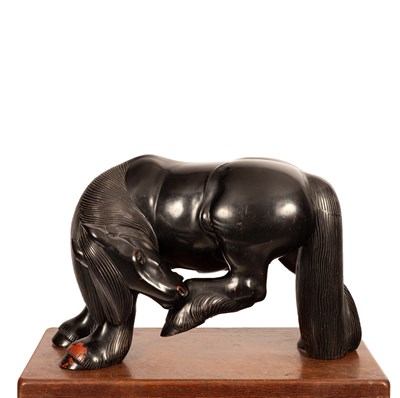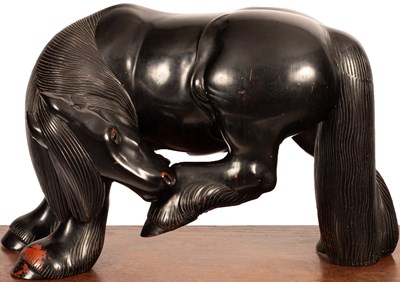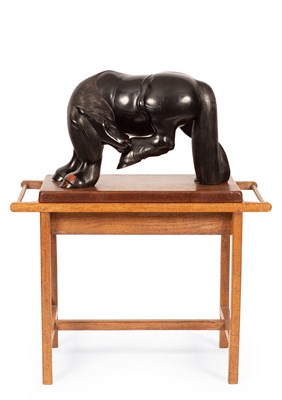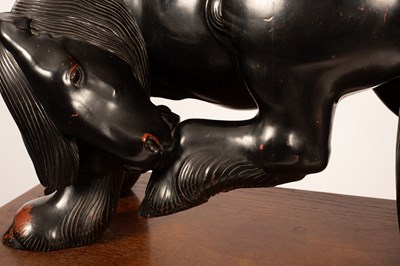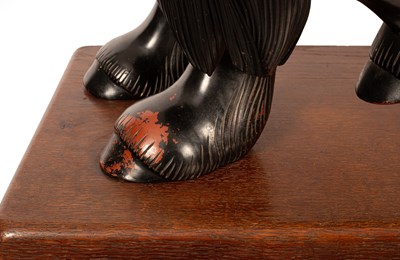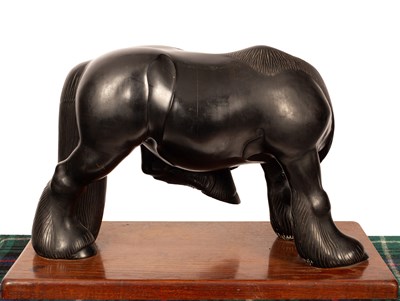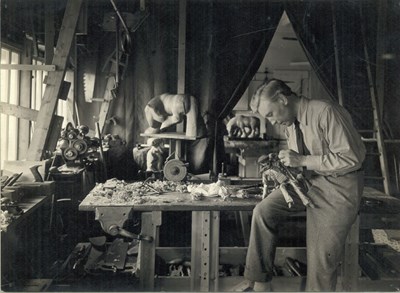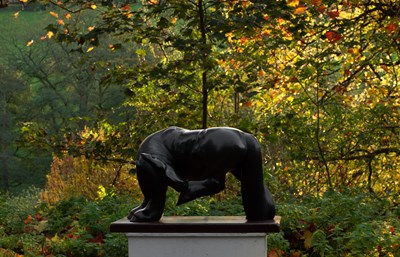21st Nov, 2023 10:00
Modern Art & Design
339
ARR William Simmonds (1876-1968)
William Simmonds (1876-1968) The Black Mare, circa 1925, a unique and important carved laminated mahogany and black lacquered wooden sculpture depicting a stylised horse turning to nip a fly or gnat on its rear leg, mounted on wooden base
48cm x 76cm x 41cm
Provenance:George Eumorfopoulos. The Countess Northesk. Private Collection.
This Black Mare was made in Simmonds' Far Oakridge workshops, Gloucestershire. From letters it is known that Simmonds refinished some of the lacquer using real amber, and made minor repairs to the piece in 1955 for the Cheltenham exhibition. It may be from this time that a replacement base was added as an early illustration appears to show a white painted base. In the same letters Simmonds refers to the Black Mare as 'perhaps my best work and one which has been very rarely seen'. This work was previously shown at the Treasures of Gloucestershire Exhibition at Chorley's Auction House 7th & 8th July 2012. Dated to 1935, but contemporary images of Simmonds' workshop and the date of its exhibition and first sale to George Eumorfopoulos in 1926 make the execution date most likely to be 1925, a full ten years earlier. 1925 is also the date given when it was exhibited at Cheltenham in an exhibition of Simmond's work in 1968
Exhibited: Arts and Crafts Exhibition Society 1926 (from whence first purchased for £500), Cheltenham Art Gallery 1955 (with Jacob Epstein), Cheltenham Art Gallery 1968, The Honourable Company of Gloucestershire at Chorley's 2012.
Nestling in a green valley on the edge of the Cotswolds, there is a certain satisfying serendipity in the arrival at Chorley's of this significant sculpture by the well regarded Arts and Crafts movement sculptor William Simmonds. A significant work, The Black Mare will celebrate its conception near Stroud almost a century ago. Very few works by Simmonds ever come to auction, and each one generates a great deal of excitement. The arrival at Chorley's of The Black Mare is an even greater cause for celebration as he considered it to be his finest work. The Black Mare was created without a particular client in mind. It is believed that Simmonds started work on it around 1925. A photograph of him working on it in his studio at this time still survives.
Of all Simmonds' works, The Black Mare is probably the most imposing, monumental and striking. His knowledge and admiration for Japanese art, combined with his deep respect for the Cotswolds environment in which he then lived, all feed into the conception and presentation of this exquisite work. The black lacquer finish very much adds to the Japanese aesthetic and lends the work an incredibly modern feeling, the monochrome only serving to increase the bold visual and physical nature of this piece.
The Black Mare was first sold in 1926 to an eminent British collector, famed for his exquisite taste in Japanese and Chinese ceramics and his deep knowledge of the Far East. George Eumoforpoulos had acrued his wealth through shipping and his enthusiasm led to the creation of the Oriental Ceramic Society. The Black Mare went into his Chelsea Embankment house alongside significant Medieval and Renaissance Art and eighteenth century porcelain. His attention was drawn to the work by William Rothenstein, the prominent artist, lecturer, and writer, who was an enthusiastic champion of Simmonds. Simmonds was born in Istanbul in 1876 and trained initially as an architect under his father's guidance for four years.
After fine art education at the RCA in 1893 with Walter Crane and then at the Royal Academy Schools for five years, Simmonds eventually settled in the Cotswold village of Far Oakridge in 1919, but not before he had also helped to design tanks and aeroplanes during the Great War with De Havilland amongst others. He turned his hand to sculpture and wood carving around this time too, inspired in part by the arts of Japan, especially the naturalistically carved ivory netsuke of the Classical period. Indeed, in his late youth, Simmonds was known to walk around when far from home with a small knife and chunks of ivory in his pocket.
His friends in the Cotswolds included local designers and craftsmen such as Sidney Barnsley and Fred Gardiner, as well as the painters and ceramicists Alfred and Louise Powell. His sensitive and observational precision is a remarkable combination of his technical training and artistic temperament and in recent years his sculptures, miniature carvings and puppets have become even more valued than they were during his lifetime.
Simmonds was well regarded by his contemporaries and, although he did show at the RA with a few pieces each year, he was content to live frugally on the proceeds of just a few sales. His works often took months to complete and he would frequently leave a project to return to it later. He exhibited locally within the Cotswold community including at Chipping Camden, Painswick and Cheltenham, where a retrospective show of his work was held in 1968. The Black Mare itself, at that time held in a private collection, was displayed at Chorley's once before in 2012 when it was on loan for the Treasures of Gloucestershire Exhibition
Footnote:Offered together with documentation and letters from Simmonds to the previous owner The Countess Northesk as well as her letters to Cheltenham Art Gallery. The image of William Simmonds in his studio is reproduced with the kind permission of the © holder – The Museum of Gloucester’
Sold for £45,000
William Simmonds (1876-1968) The Black Mare, circa 1925, a unique and important carved laminated mahogany and black lacquered wooden sculpture depicting a stylised horse turning to nip a fly or gnat on its rear leg, mounted on wooden base
48cm x 76cm x 41cm
George Eumorfopoulos. The Countess Northesk. Private Collection.
This Black Mare was made in Simmonds' Far Oakridge workshops, Gloucestershire. From letters it is known that Simmonds refinished some of the lacquer using real amber, and made minor repairs to the piece in 1955 for the Cheltenham exhibition. It may be from this time that a replacement base was added as an early illustration appears to show a white painted base. In the same letters Simmonds refers to the Black Mare as 'perhaps my best work and one which has been very rarely seen'. This work was previously shown at the Treasures of Gloucestershire Exhibition at Chorley's Auction House 7th & 8th July 2012. Dated to 1935, but contemporary images of Simmonds' workshop and the date of its exhibition and first sale to George Eumorfopoulos in 1926 make the execution date most likely to be 1925, a full ten years earlier. 1925 is also the date given when it was exhibited at Cheltenham in an exhibition of Simmond's work in 1968
Exhibited: Arts and Crafts Exhibition Society 1926 (from whence first purchased for £500), Cheltenham Art Gallery 1955 (with Jacob Epstein), Cheltenham Art Gallery 1968, The Honourable Company of Gloucestershire at Chorley's 2012.
Nestling in a green valley on the edge of the Cotswolds, there is a certain satisfying serendipity in the arrival at Chorley's of this significant sculpture by the well regarded Arts and Crafts movement sculptor William Simmonds. A significant work, The Black Mare will celebrate its conception near Stroud almost a century ago. Very few works by Simmonds ever come to auction, and each one generates a great deal of excitement. The arrival at Chorley's of The Black Mare is an even greater cause for celebration as he considered it to be his finest work. The Black Mare was created without a particular client in mind. It is believed that Simmonds started work on it around 1925. A photograph of him working on it in his studio at this time still survives.
Of all Simmonds' works, The Black Mare is probably the most imposing, monumental and striking. His knowledge and admiration for Japanese art, combined with his deep respect for the Cotswolds environment in which he then lived, all feed into the conception and presentation of this exquisite work. The black lacquer finish very much adds to the Japanese aesthetic and lends the work an incredibly modern feeling, the monochrome only serving to increase the bold visual and physical nature of this piece.
The Black Mare was first sold in 1926 to an eminent British collector, famed for his exquisite taste in Japanese and Chinese ceramics and his deep knowledge of the Far East. George Eumoforpoulos had acrued his wealth through shipping and his enthusiasm led to the creation of the Oriental Ceramic Society. The Black Mare went into his Chelsea Embankment house alongside significant Medieval and Renaissance Art and eighteenth century porcelain. His attention was drawn to the work by William Rothenstein, the prominent artist, lecturer, and writer, who was an enthusiastic champion of Simmonds. Simmonds was born in Istanbul in 1876 and trained initially as an architect under his father's guidance for four years.
After fine art education at the RCA in 1893 with Walter Crane and then at the Royal Academy Schools for five years, Simmonds eventually settled in the Cotswold village of Far Oakridge in 1919, but not before he had also helped to design tanks and aeroplanes during the Great War with De Havilland amongst others. He turned his hand to sculpture and wood carving around this time too, inspired in part by the arts of Japan, especially the naturalistically carved ivory netsuke of the Classical period. Indeed, in his late youth, Simmonds was known to walk around when far from home with a small knife and chunks of ivory in his pocket.
His friends in the Cotswolds included local designers and craftsmen such as Sidney Barnsley and Fred Gardiner, as well as the painters and ceramicists Alfred and Louise Powell. His sensitive and observational precision is a remarkable combination of his technical training and artistic temperament and in recent years his sculptures, miniature carvings and puppets have become even more valued than they were during his lifetime.
Simmonds was well regarded by his contemporaries and, although he did show at the RA with a few pieces each year, he was content to live frugally on the proceeds of just a few sales. His works often took months to complete and he would frequently leave a project to return to it later. He exhibited locally within the Cotswold community including at Chipping Camden, Painswick and Cheltenham, where a retrospective show of his work was held in 1968. The Black Mare itself, at that time held in a private collection, was displayed at Chorley's once before in 2012 when it was on loan for the Treasures of Gloucestershire Exhibition
Offered together with documentation and letters from Simmonds to the previous owner The Countess Northesk as well as her letters to Cheltenham Art Gallery. The image of William Simmonds in his studio is reproduced with the kind permission of the © holder – The Museum of Gloucester’
Generally good condition overall, with a few issues. There are three narrow bands or incisions wrapping around the middle of the sculpture, which are particularly apparent where the lacquer has thinned. Given that they appear where the lacquer surface has thinned, these most likely indicate joins made in the compositional process. Sparately from this, there are many small, relatively minor surface scratches and abrasions. There are some losses to the lacquer in places, especially around the left hoof and to some extent around the nose and eye, where the red under-layer shows through very clearly (this is visible in main photography). There are some other areas where the lacquer has thinned, resulting in some cases in areas of craquelure. The sculpture would benefit from being cleaned.
All Lots are offered for sale in the condition they are in at the time of the sale. You acknowledge that many Lots are of an age and type such that they are not in perfect condition. Catalogue descriptions and condition reports may refer to imperfections of a Lot, but Lots may have other faults not expressly referred to in the Catalogue or condition report. Illustrations are for identification purposes only and may not convey full information as to the actual condition of a Lot. You accept responsibility for carrying out your own inspections and investigations of Lots in which you may be interested. You should inspect a Lot before bidding to determine and to satisfy yourself as to its condition, size, description and whether it has been repaired or restored, as applicable, and we accept bids on Lots solely on this basis. Condition reports may be available to assist when inspecting Lots. Lots will be available for viewing in person at our premises or another location and viewing information will be available on our website.
Auction: Modern Art & Design, 21st Nov, 2023
Chorley's autumn modern art & design sale spans the modern era from from the early 19th century to contemporary art and design. The auction includes a broad selection of Arts & Crafts furniture and works of Art, including a collection from the studio of William Simmonds and his seminal work of 'The Black Mare'.
Viewing
19th November 2023 | 10am - 4pm
20th November 2023 | 9am - 4pm
